Key takeaways:
- Effective onboarding is crucial for shaping a new employee’s experience, fostering connections, and improving retention rates.
- Key components of successful onboarding include structured orientation, mentorship, and active feedback mechanisms.
- Creating a welcoming environment with personalized greetings and team activities enhances comfort and engagement for new hires.
- Measuring onboarding success through feedback loops and retention rates helps organizations refine their processes and support employee integration.
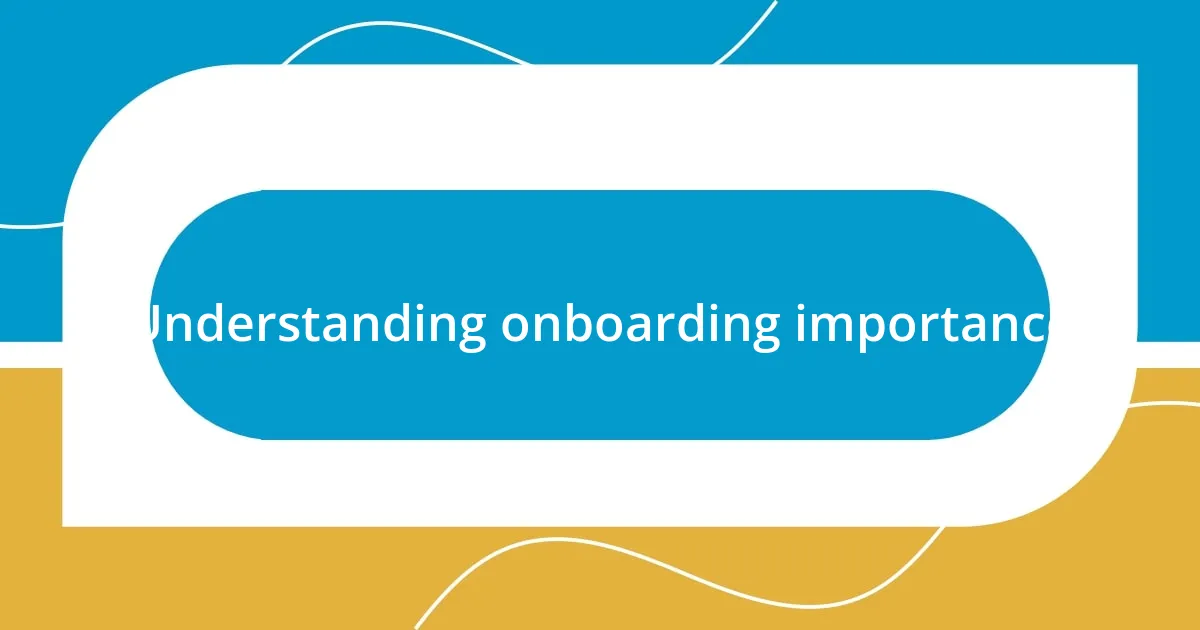
Understanding onboarding importance
Onboarding is essential because it shapes a new employee’s experience and sets the tone for their future with the company. I remember my first onboarding process felt overwhelming – the sheer volume of information was daunting. Have you ever had that feeling of being tossed into the deep end? A well-structured onboarding can turn that anxiety into excitement, helping new hires feel valued from day one.
When I reflect on my journey, I realize that effective onboarding is not just about paperwork; it’s about connection. Early interactions can foster relationships that lead to teamwork and collaboration down the line. I often wonder, how can companies overlook this crucial phase? When new employees feel connected and supported, they’re much more likely to invest in their roles.
Moreover, integrating new hires properly can significantly impact retention rates. I recall a friend who left a job after just a few months because their onboarding process was lackluster. It hit home for me how much this phase can influence an employee’s long-term commitment. Companies that prioritize onboarding not only reduce turnover but also cultivate a culture of loyalty and engagement. Isn’t that something every organization should strive for?
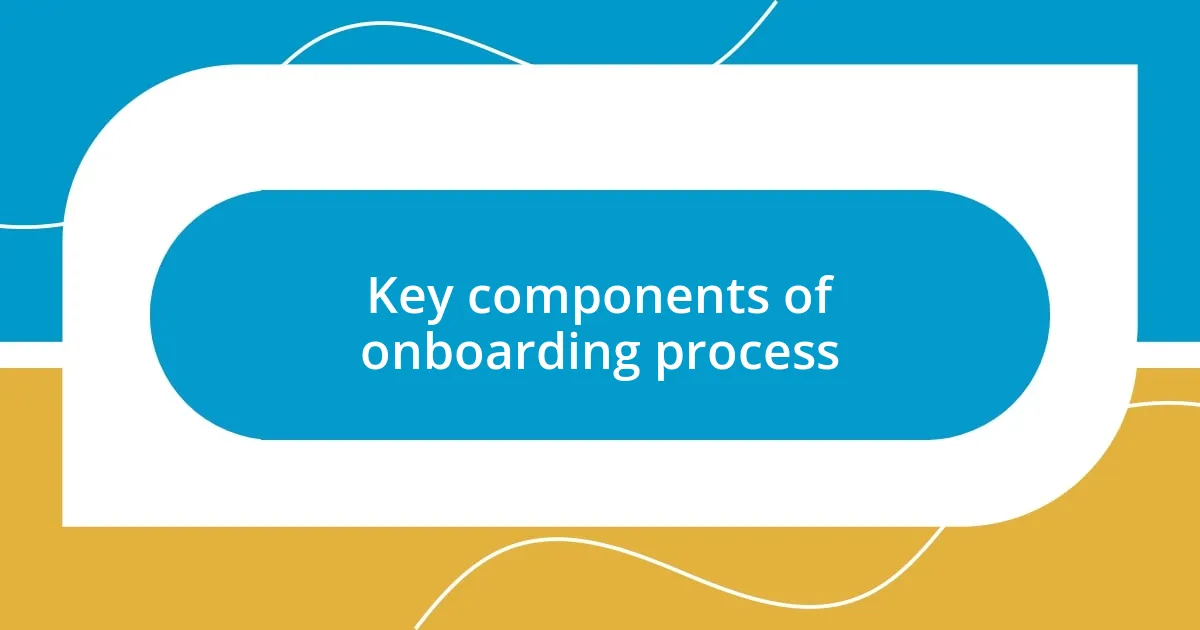
Key components of onboarding process
Effective onboarding processes encompass several key components that streamline the transition for new employees. From my experience, a structured orientation program is vital. I once joined a company that kicked off my onboarding with a detailed roadmap, allowing me to grasp what to expect in my first week. This clarity not only built my confidence but also set the stage for my welcoming into the team.
Another critical element is mentorship. I remember early in my career, I was paired with a seasoned colleague who provided insights and guidance during my initial days. This one-on-one connection offered me a safety net that helped me navigate through uncertainties. It’s incredible how having that support can nurture professional growth and encourage new hires to seek assistance when needed.
Lastly, feedback mechanisms are crucial in the onboarding process. I vividly recall receiving a mid-way survey during my onboarding experience, asking how well I felt integrated into the team. This simple act of checking in made me feel heard and valued. When organizations actively seek feedback, it not only refines the onboarding strategy but also reinforces the new hire’s sense of belonging. Isn’t that what we all want when starting a new chapter in our careers?
| Component | Description |
|---|---|
| Structured Orientation | A clear roadmap of activities and expectations in the initial days. |
| Mentorship | Pairing new hires with experienced colleagues for guidance and support. |
| Feedback Mechanisms | Active solicitation of input from new employees to refine onboarding processes. |
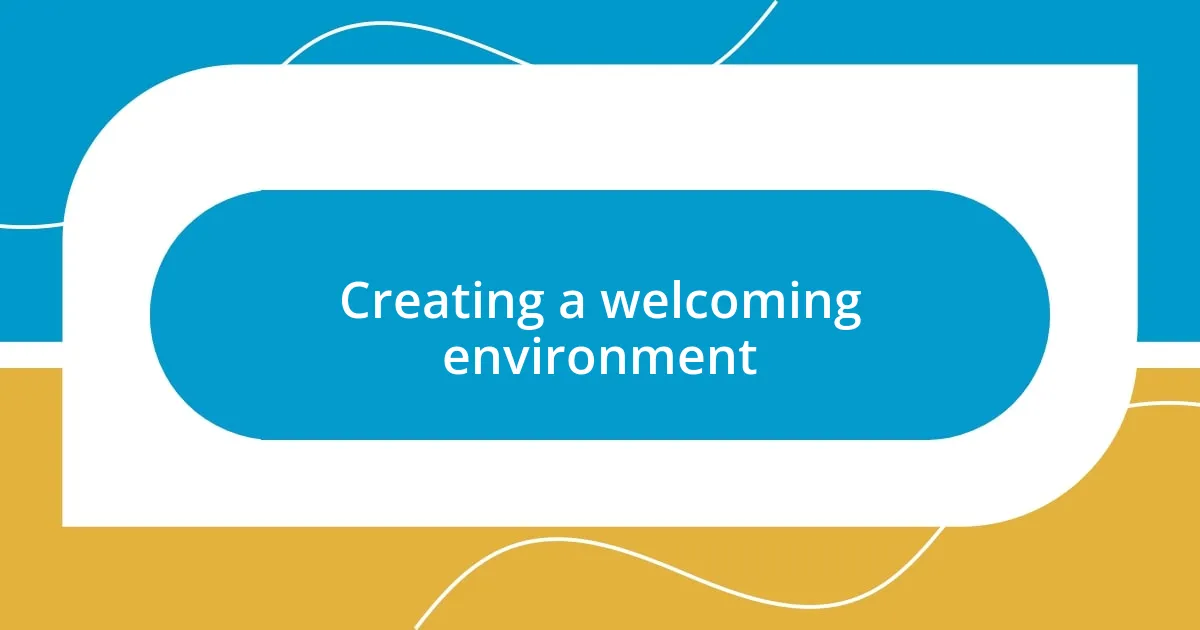
Creating a welcoming environment
Creating a welcoming environment is essential for new employees to feel comfortable and engaged from the start. Reflecting on my experiences, I recall one organization that transformed the office into a warm and inviting space for each new hire’s first day. The bright decorations, personalized welcome notes, and even a small welcome breakfast created an atmosphere that felt like a celebration. This simple gesture of hospitality made a lasting impression and helped melt away any initial anxiety I had.
To foster a welcoming environment, consider the following:
- Personalized Greetings: Make it a point for team members to personally welcome new hires. A friendly smile and a warm handshake can make all the difference.
- Comfortable Workspace: Ensure that workspaces are inviting and well-equipped, providing newcomers with a sense of ownership from day one.
- Inclusive Team Activities: Organize informal team activities, like coffee breaks or lunches, to encourage socialization and create bonds early on.
- Visual Welcome: Use visual cues like welcome banners or team introductions displayed prominently within the office to extend a sense of belonging.
- Supportive Resources: Offer easy access to resources such as handbooks or buddy systems that guide new employees through their initial days.
Building a welcoming environment not only eases the transition but can also cultivate lasting relationships within the team. I remember the instant camaraderie I felt when my colleagues made an effort to include me in their discussions right off the bat. It’s moments like these that sow the seeds of collaboration and teamwork, transforming a job into a meaningful experience.
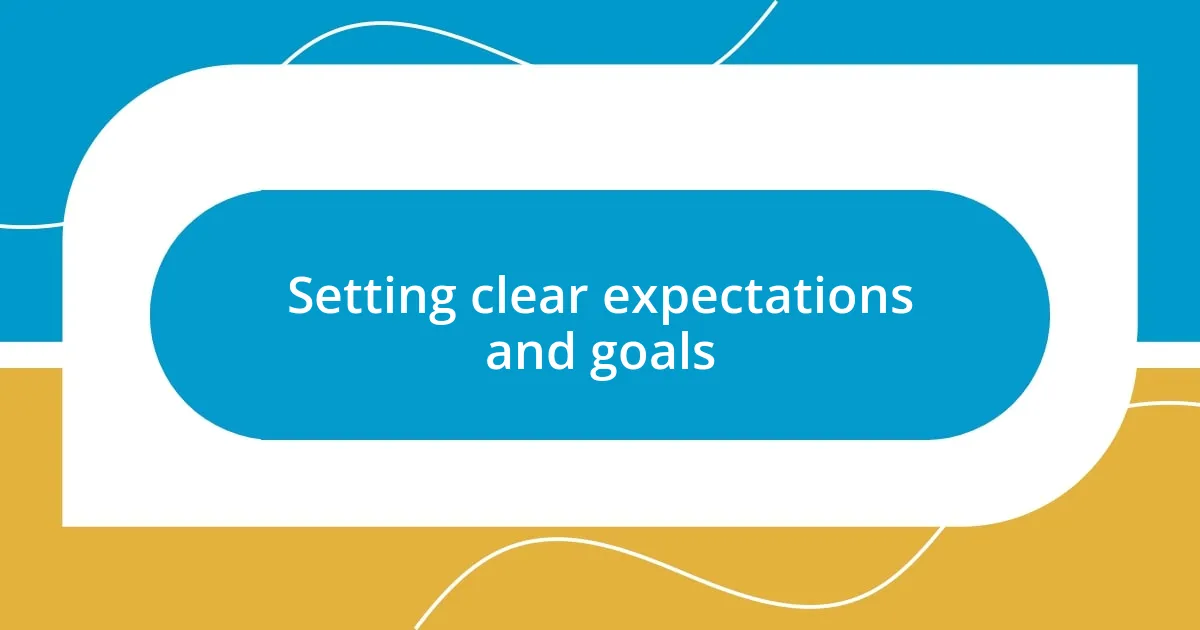
Setting clear expectations and goals
Setting clear expectations and goals is crucial in any onboarding process. I recall starting a new position where my manager and I discussed specific targets right from the outset. This conversation made me feel empowered and clear about my role, reducing the confusion that often accompanies a new job. It’s fascinating how aligning expectations upfront can lead to a greater sense of accountability and motivation.
I believe that establishing measurable goals is equally important. For instance, in one company, we set weekly check-ins to assess progress toward objectives. These meetings allowed for real-time adjustments and support from my supervisor, which was invaluable. Have you ever felt lost without a clear target to aim for? I certainly have, and having concrete goals helped to ground me and ensure I was on the right path.
Moreover, I think it’s beneficial to communicate the bigger picture. During my onboarding at a tech firm, I learned how my role contributed to the overall mission of the company. This context not only made me feel more connected to my work but ignited a sense of passion within me. When new hires understand how their efforts fit into the larger goals of an organization, it transforms their motivation and engagement levels. Isn’t it amazing how a little clarity can spark excitement and commitment?
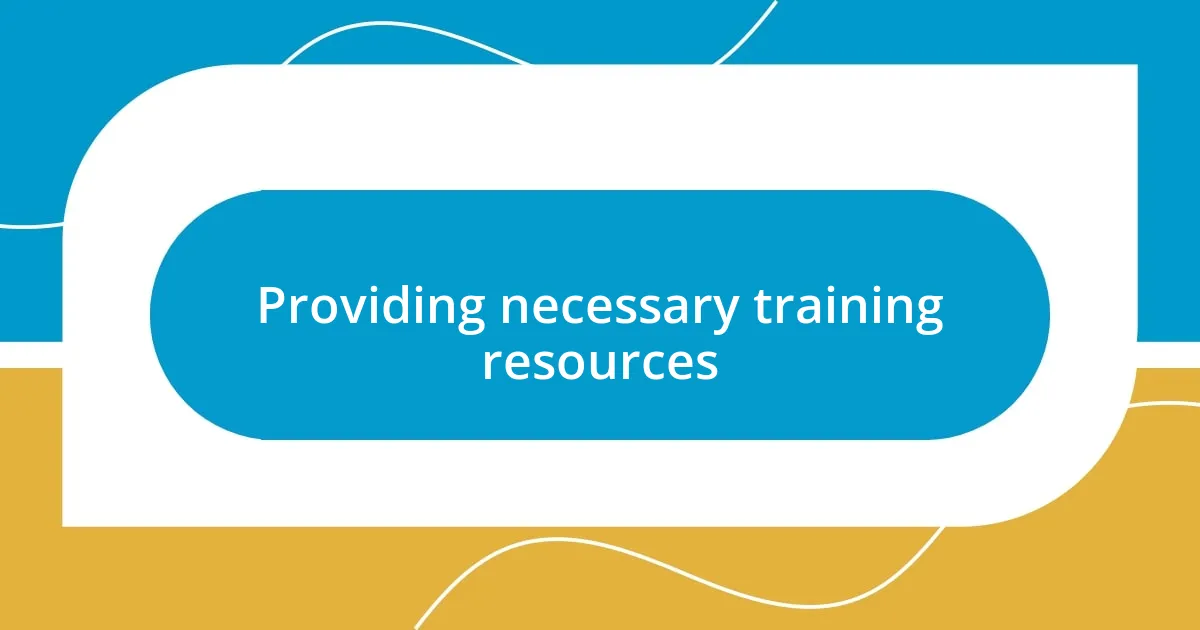
Providing necessary training resources
Providing essential training resources is a pivotal part of onboarding that can set the stage for success. I remember one company where each new employee received a carefully curated training pack, including online modules and printed guides. This thoughtful approach made me feel well-equipped and supported, easing me into my new role without feeling overwhelmed.
In my experience, hands-on training can be incredibly impactful. At one point, I was part of an onboarding program that paired new hires with seasoned employees for a few days. Reflecting on those days, I felt much more confident and capable as I learned the ropes through direct engagement. Being able to ask questions in real-time and observe best practices solidified my understanding and made the transition smoother. Have you ever found that learning alongside someone experienced helped you grasp complex concepts? I certainly did, and it emphasized how essential these resources are.
Additionally, the availability of diverse training formats can cater to different learning styles. I recall a job where some training modules were delivered via interactive workshops while others were accessible online. This mixture allowed me to experiment with what worked best for me. I truly felt respected as a learner, and it inspired me to engage more actively. When organizations invest in tailored training resources, they not only enhance skills but also nurture a culture of continuous growth.
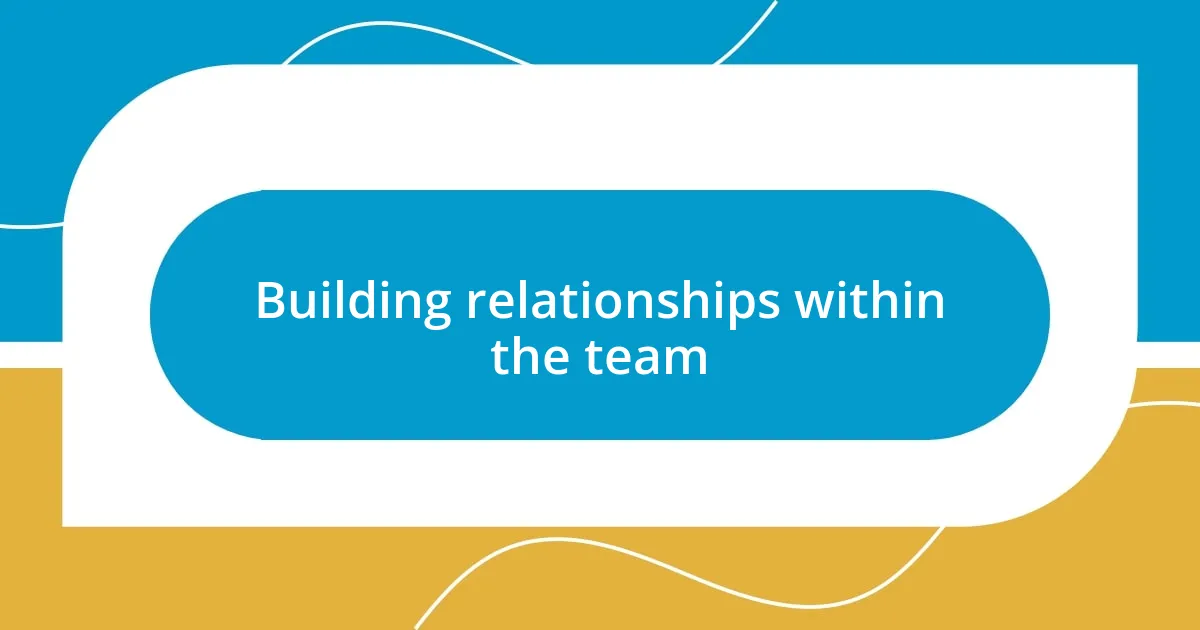
Building relationships within the team
Building relationships within the team is essential to creating a welcoming environment during onboarding. I vividly remember my first day at a new job, where my team surprised me with a welcome lunch. It wasn’t just about the food; that kindness instantly made me feel included. Have you ever felt that rush of relief when a stranger becomes a friend? In my case, it shifted my mindset from being an outsider to a valued member of the team.
Connecting with colleagues can also happen through shared activities. At one organization, we had a weekly team-building exercise, which was a fantastic way to break the ice. I recall a game we played that involved solving puzzles together, and while it was fun, it also revealed how everyone brought unique strengths to the table. Those moments built trust among us and fostered communication that carried over into our work. How often do team dynamics shift positively after shared experiences? From my perspective, it’s astonishing how a simple game can lay the groundwork for collaboration.
Furthermore, it’s vital to maintain open lines of communication from day one. I once joined a team where we had a dedicated Slack channel for new hires, allowing us to ask questions freely and get instant responses. The support from both peers and managers helped forge connections that went beyond mere workplace interactions. Reflecting on that experience, I can honestly say—how can we flourish in our roles without a solid network of support? Building those relationships early can create a sense of belonging, making the transition into a new role feel more like a team effort rather than a solo journey.
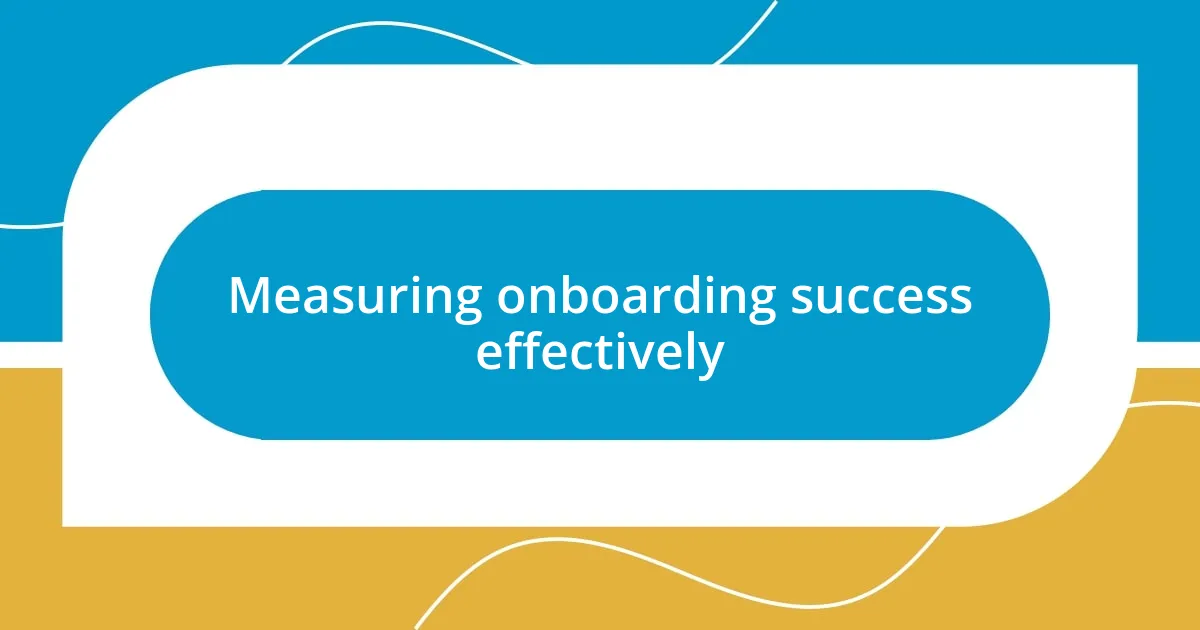
Measuring onboarding success effectively
Measuring the success of onboarding is more than just checking off a few training modules. I remember during one onboarding program I participated in, we were encouraged to share feedback through quick surveys after our first few weeks. This approach not only made me feel like my opinion mattered, but it also highlighted areas where the onboarding process could improve. Have you ever noticed how a simple feedback loop can enhance learning experiences? It’s a crucial element in assessing how well new hires are integrating into the organization.
One key metric I found particularly impactful was tracking employee engagement during and after onboarding. At one point, my team introduced regular check-ins to discuss progress and address any lingering concerns. These sessions helped to ensure that everyone felt supported and on track. I distinctly recall how much more motivated I felt when I could openly share my experiences and suggest modifications to the onboarding process. How often do we find that a little dialogue can transform our feelings of uncertainty into enthusiasm?
Finally, retention rates serve as a powerful indicator of onboarding success. I’ve seen organizations that carefully analyze turnover data in the first year, revealing insights into how well employees adapted to their roles. In one case, after implementing a more structured onboarding program, the company saw a sharp decline in early attrition. It made me ponder: if onboarding is a foundation, shouldn’t we be vigilant about its quality? Ensuring comprehensive onboarding doesn’t just welcome new hires; it lays the groundwork for their long-term happiness and success within the company.














